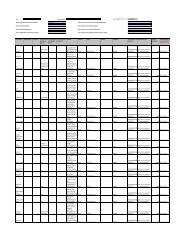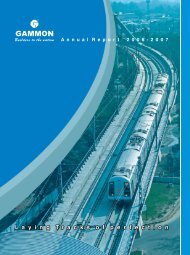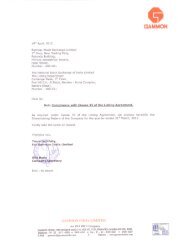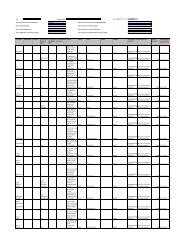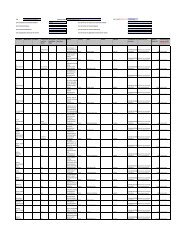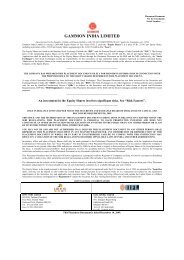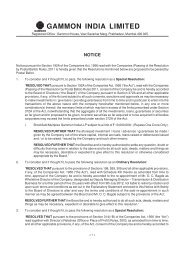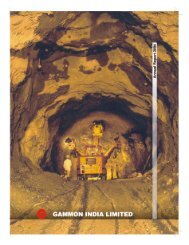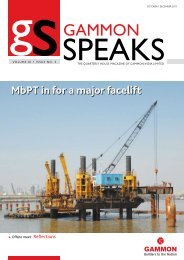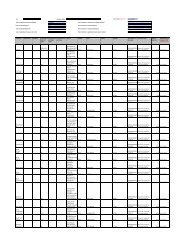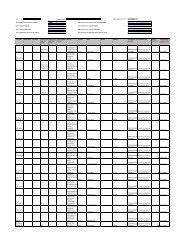Annual Report 2010-2011 - Gammon India
Annual Report 2010-2011 - Gammon India
Annual Report 2010-2011 - Gammon India
You also want an ePaper? Increase the reach of your titles
YUMPU automatically turns print PDFs into web optimized ePapers that Google loves.
(c) Depreciation on revalued component of the assets is withdrawn from the Revaluation Reserve.<br />
(d) The depreciation on assets used for construction has been treated as period cost.<br />
(e) Depreciation on assets situated in countries outside <strong>India</strong> are accounted at the rates of depreciation prescribed as per the relevant local<br />
laws of such countries which are as follows except in case of Oman Branch where the depreciation is as per Schedule XIV.<br />
Assets Category Kenya Nigeria Algeria Bhutan<br />
Computers 30% — 15% 15%<br />
Furniture and Fittings 12.50% 10% 15% 15%<br />
Plant and Machineries — 15% 15% 15%<br />
Office Equipments — 15% 15% 15%<br />
Electrical fittings — 15% — 15%<br />
SPC Tools — — 15% —<br />
Vehicles — — 20% 15%<br />
Building/Store Cabin — — 5% —<br />
(f) Intangible assets are amortised uniformly over three years.<br />
9. Impairment of Assets:<br />
On annual basis Company makes an assessment of any indicator that may lead to impairment of assets. An asset is treated as impaired when<br />
the carrying cost of asset exceeds its recoverable value. Recoverable amount is higher of an asset’s net selling price and its value in use. Value<br />
in use is the present value of estimated future cash flows expected to arise from the continuing use of an asset and from its disposal at the end<br />
of its useful life.<br />
An impairment loss is charged to the Profit and Loss Account in the year in which an asset is identified as impaired.<br />
The impairment loss recognized in prior accounting period is reversed if there has been a change in the estimate of recoverable amount.<br />
10. Investments:<br />
Investments that are readily realisable and intended to be held for not more than a year are classified as current investments. All other<br />
investments are classified as long-term investments. Current investments are carried at lower of cost and fair value determined on an individual<br />
investment basis. Long-term investments are carried at cost. However, provision for diminution in value is made to recognise a decline other<br />
than temporary in the value of long term investments.<br />
11. Cash and cash equivalents:<br />
Cash and cash equivalents in the balance sheet comprise cash at bank and in hand and short-term investments with an original maturity of three<br />
months or less.<br />
12. Inventories:<br />
(a) Raw materials are valued at cost, net of Excise duty and Value Added Tax, wherever applicable. Stores and spares, loose tools are valued<br />
at cost except unserviceable and obsolete items that are valued at estimated realizable value thereof. Costs are determined on FIFO<br />
method.<br />
(b) Stores and Construction Materials are valued and stated at lower of cost or net realisable value. The FIFO method of inventory valuation<br />
is used to determine the cost.<br />
(c) Work-in-Progress on construction contracts reflects value of material inputs and expenses incurred on contracts including estimated profits<br />
in evaluated jobs.<br />
(d) Work-in-progress from manufacturing operation is valued at cost and costs are determined on FIFO method.<br />
(e) Finished Goods are valued at cost or net realizable value, whichever is lower. Costs are determined on FIFO method.<br />
13. Foreign Currency Translation:<br />
(a) Transactions in foreign currencies are recorded at the exchange rate prevailing on the date of transactions.<br />
(b) Current Assets and Current Liabilities are translated at the year end rate or forward contract rate.<br />
(c) Any Gain or Loss on account of exchange difference either on settlement or translation is recognized in the Profit and Loss Account.<br />
(d) Fixed Assets acquired in foreign currencies are translated at the rate prevailing on the date of Bill of Lading.<br />
(e) The transactions of Oman branch are accounted as a non-integral operation. The related exchange difference on conversion is accounted<br />
under Foreign Currency Translation Reserve Account.<br />
(f) The transactions of branches at Kenya, Nigeria, Algeria, Bhutan and Italy are accounted as integral operation.<br />
(g) The exchange gain/loss on long term loans to non integral operations being subsidiaries are restated to Foreign Exchange Translation<br />
Reserve Account and will be transferred to the profit & loss account in the year when the disposal or otherwise transfer of the operations<br />
are done.<br />
A NNUAL R EPORT I <strong>2010</strong>/11<br />
81





